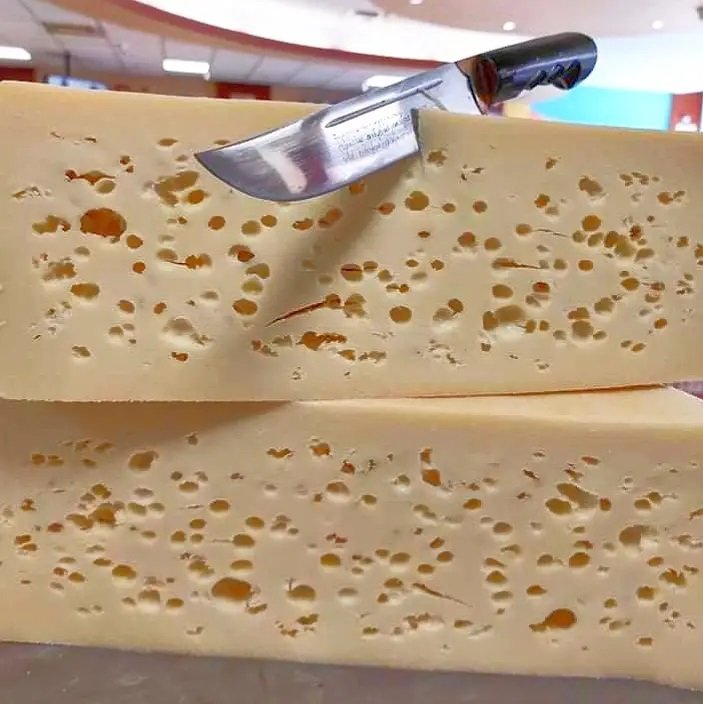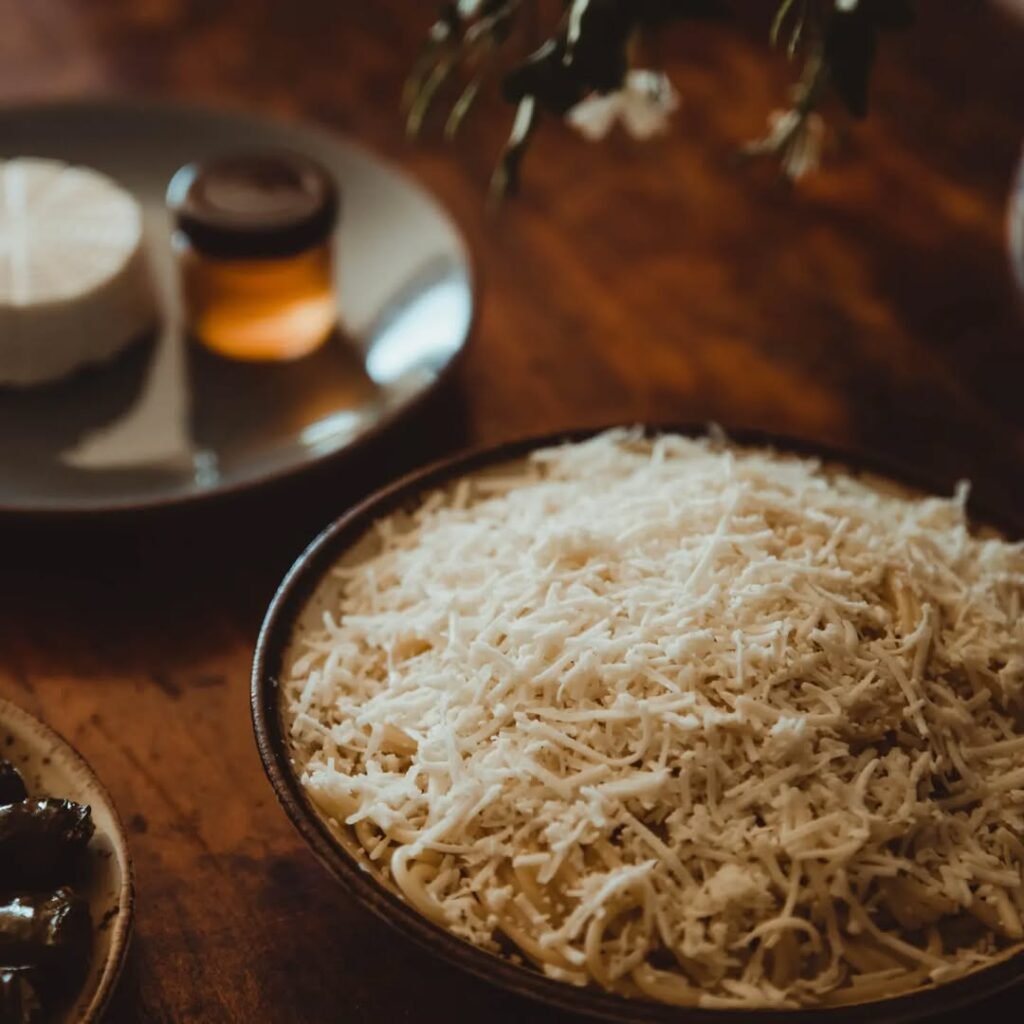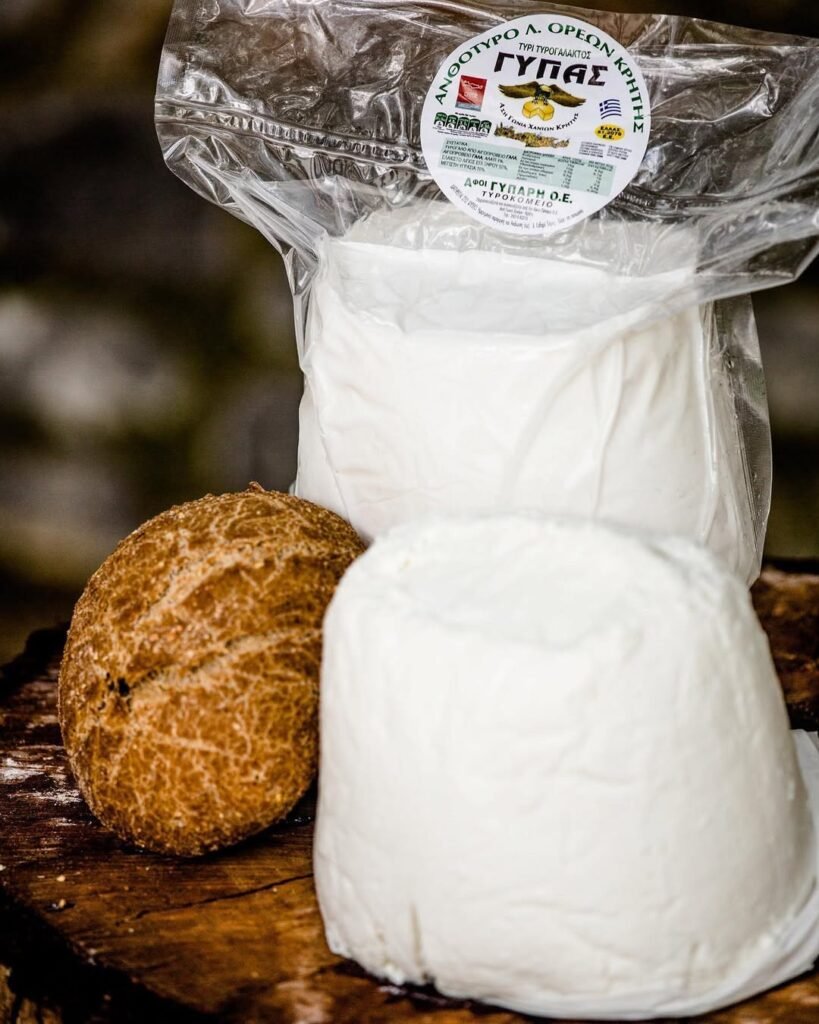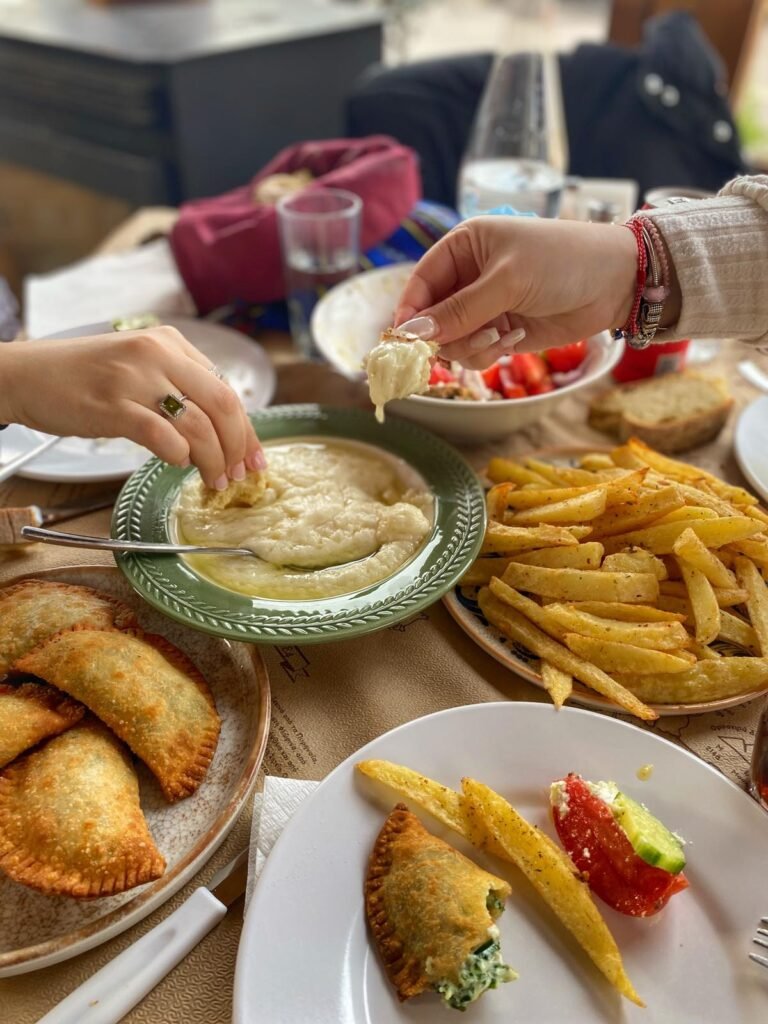Let me tell you – once you’ve had a slice of Cretan cheese, even that simple block of feta on your Greek salad back home will never taste quite the same. Trust me, I’ve been there! There’s something about Crete’s centuries-old cheesemaking tradition that transforms every bite into an unforgettable experience.
From the nutty complexity of PDO-protected Graviera to the fresh tang of Xynomizithra, each variety carries stories of mountain shepherds and village traditions that span over 3,000 years. Whether you’re a serious cheese enthusiast or just someone who appreciates good food, the distinctive flavors of Cretan cheese offer something truly special that you won’t find anywhere else in the world.
And at the end of this guide, I’ll share details about an incredible farm and cheese factory tour I personally experienced – where you can taste warm, freshly made cheese and even try your hand at traditional cheesemaking!
What Makes Cretan Cheese So Special?
Let’s be honest – lots of regions claim to have the best cheese. But Crete’s exceptional varieties come from a perfect combination of geography, history, and culture that’s completely unique to this island. The cheesemaking tradition here stretches back over 3,000 years to the Minoan civilization, with techniques carefully passed down through countless generations of dedicated shepherds and artisans.
Here’s what really sets Cretan cheese apart: the milk comes from sheep and goats that roam freely across the island’s rugged terrain, grazing on wild herbs like thyme, oregano, and sage. This natural diet gives the milk flavors that simply can’t be replicated anywhere else.
And get this – Cretans hold the world record for cheese consumption per person! Yes, they eat more cheese than even the French! From a simple breakfast of cheese drizzled with local thyme honey to late-night meze paired with raki, cheese is practically a family member in every Cretan household.

Now, let’s dive into the 8 cheese varieties that’ll make your taste buds sing – each with its own personality, history, and perfect pairing suggestions.
- Graviera Cheese: The King of Cretan Cheeses
If there’s one cheese that truly captures the essence of Crete, it’s Graviera. This PDO-protected flagship cheese has held its Protected Designation of Origin status since 1996, which means only cheese made in designated regions using traditional methods can carry this prestigious name.
Made primarily from sheep’s milk or sometimes a blend with goat’s milk, Graviera’s flavor profile evolves beautifully with age. When young, it’s delightfully sweet, nutty, and buttery. Give it a few months—preferably 3 to 6 months maturing in a cave—and it develops those caramelized notes that make cheese lovers weak at the knees. It’s no wonder TasteAtlas ranked Graviera Kritis as Europe’s 5th best pasteurized milk cheese in 2025, based on tens of thousands of verified cheese ratings from around the world.
The texture is equally impressive: firm and light yellow with those characteristic small irregular holes, and an oily feel that tells you it’s the real deal. You’ll even spot the crisscross pattern on the natural rind – marks left by the traditional draining cloth.

Now, here’s something interesting about Graviera – people often call it the “Greek Gruyère,” and there’s a good reason for that similarity. But like many great debates in the cheese world, not all Graviera is created equal. Cretan Graviera is notably sharper and saltier than its Naxos cousin, which uses cow’s milk and tastes buttery and mild. Even within Crete, you’ll find the flavor changing from batch to batch, depending on what the animals were grazing on that season.
This variability sometimes drives cheesemakers crazy – there’s ongoing debate about what truly qualifies as Graviera when different milks or techniques are used. But for us cheese lovers? It’s the perfect excuse to taste your way across Crete, discovering how each farmer puts their own spin on this beloved cheese.
How to enjoy Cretan Graviera (PDO):
- Drizzle it with local thyme honey for breakfast
- Grate it generously over pasta
- Pair it with a chilled rosé wine or raki
- Try it with melon for a refreshing summer snack
Since 1914, when Graviera production began in earnest on Crete, this cheese has become more than just food – it’s a source of regional pride. And while it’s the second most popular Greek cheese after feta, many visitors rate it higher precisely because it feels like discovering a delicious secret that hasn’t yet traveled widely beyond Greece’s borders.

2. The Mizithra Family: Fresh, Tangy, and Traditional
If Graviera is the king of Cretan cheeses, then the Mizithra family must be the versatile royal court. These ancient Cretan cheeses have been gracing Cretan tables for thousands of years – legend even credits the culture hero Aristaios with their invention!
Meet the Family Members
The Mizithra family tree has three distinct branches, each with its own personality:
Fresh Mizithra: Snow-white and creamy, with a mild sweetness that reminds you of ricotta. It’s perfect for spreading on warm bread with honey or filling traditional Sfakiani pita.
Dried Mizithra: When fresh Mizithra is salted and aged, it transforms into a firm, crumbly cheese that’s perfect for grating. This is the version that makes pasta sing – especially when paired with browned butter (a combination made famous by The Old Spaghetti Factory).
Xynomizithra: The tangy rebel of the family (literally “sour mizithra”). This PDO-protected cheese develops its signature sourness through natural fermentation, creating a yogurt-like consistency that’s perfect for dips and pies.

And Then There’s Galomyzithra
While Mizithra and Xynomizithra are made from whey, Galomyzithra (from “gala” meaning milk) is the proud outlier – made directly from fresh milk through natural acidification. This creates a soft, spreadable cheese that’s often called “the ricotta of Crete.”
With its short shelf life of just a few days, Galomyzithra is the ultimate local delicacy. It’s the cheese Cretans reach for at breakfast, spreading it on bread with olive oil and oregano, or using it to make the famous dakos salad.
Production Secrets
Traditional Mizithra and Xynomizithra use about 7 parts milk to 3 parts whey from previous cheesemaking sessions. The whey is boiled at temperatures well above pasteurization, making these among the safest fresh cheeses you can eat. Galomyzithra skips the whey altogether, relying on milk’s natural tendency to curdle.
How to enjoy the Mizithra family:
- Fresh Mizithra: spread on bread with thyme honey
- Dried Mizithra: grate over pasta with browned butter
- Xynomizithra: make tirosalata dip with olive oil and oregano
- Xynomizithra: fill traditional kalitsounia pies
- Galomyzithra: top dakos (Cretan barley rusks) for classic salad
- Galomyzithra: use in Chania-style bougatsa pastries

The most heated debates among Cretan cheese lovers? Whether these are truly different cheeses or just variations on a theme. But one thing’s certain – whether it’s the smell of grated Mizithra over hot pasta or the fresh tang of Galomyzithra at breakfast, these cheeses carry the taste of generations of Cretan tradition.
3. Anthotyro: From Fresh to Aged Perfection
They say Anthotyro got its name from “anthos” (flower) because of the wild herbs that Cretan sheep and goats graze on – and let me tell you, this “flowery cheese” truly lives up to its poetic name. While it might be the shy cousin of Mizithra, Anthotyro holds its own as one of Crete’s most versatile dairy treasures.
The Two Faces of Anthotyro
Like many Cretan cheeses, Anthotyro has a split personality that keeps things interesting:
Fresh Anthotyro is soft, creamy, and mildly sweet – the kind of cheese that makes breakfast feel like a celebration. I once watched a local yiayia in Rethymno drizzle fresh Anthotyro with honey, pair it with figs from her garden, and then insist I try it on the spot. Simple? Yes. Unforgettable? Absolutely.
Dry Anthotyro (Anthotyro Xero) is a completely different beast. After about 10 days of aging with extra salt, it becomes firm, crumbly, and intensely flavorful – some say it develops a sherry-like aroma that can knock your socks off! While some find it overwhelming on its own, grated over pasta or salads, it’s absolutely transformative.

Making Anthotyro: The Cretan Way
The production process is fascinating: milk is boiled, then rennet and salt are added. The mixture drains in tulle-lined baskets, gets salted daily for several days, and voilà – you’ve got fresh Anthotyro in 3-4 days. Want it dry? Just keep aging and salting.
Traditional cheesemakers sometimes hang their Anthotyro in muslin sacks outdoors (though I’ve heard tales of curious goats helping themselves to the aging cheese!). The result? Those distinctive truncated cones or balls you’ll spot in Cretan markets.
How to enjoy Cretan Anthotyro:
- Fresh: spread on bread with honey and seasonal fruits
- Fresh: mix with olive oil and wild herbs for a simple meze
- Fresh: use as filling for traditional kalitsounia pies
- Aged: grate generously over pasta or rice dishes
- Aged: sprinkle over salads for an intense flavor boost
Here’s a little secret: outside Greece, many people substitute ricotta for fresh Anthotyro in recipes. But between us? Nothing compares to the real Cretan cheese, with its subtle flowery notes and perfect balance of sweetness and tang.

Perfect Pairings
For wine lovers, fresh Anthotyro pairs beautifully with crisp whites like Robola or Muscat, while the aged version stands up to fuller, spicier whites like Malagousia. And if you really want to impress at your next dinner party, serve fresh Anthotyro with figs and a drizzle of thyme honey – your guests will think you’ve transported them straight to a Cretan village!
4. Kefalotyri: The Hard Cheese Classic
When it comes to hard Greek cheeses, Kefalotyri stands tall as one of the oldest and most respected varieties. Its name means “head cheese” – either because of its traditional hat-like shape or its status as the “head” of Greek hard cheeses. Take your pick, both stories work!

Made primarily from sheep’s or goat’s milk (sometimes a blend of both), Kefalotyri is the cheese that can do it all. After aging for at least 3 months – though some varieties mature for over a year – it develops a distinctively salty, spicy character that’s impossible to miss.
A Cheese with Character
Here’s a fun piece of cheese history: in the 19th century, some exported Kefalotyri was so notoriously hard that locals joked it could withstand gunshots! Thankfully, today’s Kefalotyri has shed that bulletproof reputation (some producers even rebrand it as “kefalograviera” to escape the old image), but it still maintains its signature firmness.
Traditional Kefalotyri contains about 3-4% salt and was sometimes dipped in scalding hot whey to form a protective crust. While this extra-hard version is perfect for grating, some artisanal varieties are softer, closer to graviera in texture – proving that even this classic Greek cheese has room for variation.
How to enjoy Cretan Kefalotyri:
- Fried as saganaki – it holds its shape beautifully when heated
- Grated over pasta, moussaka, or pastitsio
- Mixed with feta in traditional pies like spanakopita
- Served raw with ouzo as a simple meze
- Paired with fresh pears, figs, or grapes
- Used as a local substitute for Parmesan

If you’re lucky enough to find authentic Kefalotyri outside Greece, grab it immediately – it’s one of those Greek cheese treasures that can be surprisingly hard to track down abroad. I’ve personally seen plenty of cheeses labeled as “Kefalotyri” in supermarkets outside Greece that were actually made from cow’s milk instead of the traditional sheep or goat milk. Always check that ingredients list and look for where it was made – authentic Kefalotyri should come from Greece or Cyprus and be made with sheep’s or goat’s milk.
Perfect Pairings
Kefalotyri’s robust flavor stands up beautifully to both sparkling whites and bold reds. For the authentic Cretan experience, serve it with a glass of ouzo and watch how the anise spirit brings out the cheese’s spicy notes.
5. Pichtogalo Chanion: A Creamy PDO Delicacy
If you ever find yourself in the charming city of Chania, you’re in for a treat with Pichtogalo Chanion – a PDO-protected cheese that’s as creamy as it is culturally significant. This yogurt-like Cretan cheese, made exclusively in the Chania prefecture since gaining its official PDO status in 1996, represents the very essence of western Crete’s dairy tradition.

Unlike many similar cheeses, Pichtogalo Chanion is crafted directly from fresh sheep’s or goat’s milk – not whey. This makes it richer and creamier than its cousins, with a distinctive tang that locals adore. Sheep’s milk creates a softer, creamier version, while goat’s milk yields a firmer cheese with a stronger punch – both equally delicious!
A Cheese Under Threat
Here’s something that concerns me as a cheese lover: this unique Cretan cheese is increasingly threatened by urban expansion and climate change. Production remains small-scale and traditional, with many cheesemakers still working at the same location where the milk is produced. This direct link to the land gives Pichtogalo Chanion its special character – but also makes it vulnerable to disappearing.
Traditionally produced by coagulating raw milk at 18-25°C, then acidifying for 24 hours, the cheese is drained in cloth sacks and lightly salted (just 1%). The result? A spreadable delight that locals affectionately call “Chaniotiki Mizithra.”
How to enjoy Cretan Pichtogalo Chanion:
- Spread thickly on fresh bread for a traditional Chania breakfast
- Use as filling in the famous bougatsa pastries
- Mix into kolokithompoureki (zucchini pie) or other vegetable pies
- Create a simple dip with olive oil and herbs
- Include in dakos salad for authentic Cretan flavor
- Melt into hot dishes – it works beautifully!

This Cretan cheese’s short shelf life means you’ll mostly find the fresh, unpasteurized version only in Crete (commercial versions are pasteurized for longer storage). But if you do encounter the real deal, pair it with a crisp Cretan white wine or a shot of raki – it’s how the locals do it!
6. Staka and Stakovoutyro: Unique Dairy Treasures
Let me tell you about my absolute favorite Cretan dairy discovery – staka and stakovoutyro. These unique products are practically unknown outside Crete, making them true culinary hidden gems that you simply must try!
The magic starts with skimming the creamy “skin” (tsipa) from boiled sheep’s or goat’s milk. This cream is slowly heated with a touch of flour, creating two distinct treasures: the butterfat that rises to the top becomes stakovoutyro (staka butter), while the remaining thickened cream is staka – a rich, custard-like delight that’s sometimes called “Cretan fondue.”

A Western Crete Specialty
These dairy treasures are almost exclusively found in western Crete, particularly Chania. I’ll never forget my first staka me avga (eggs fried in stakovoutyro and topped with creamy staka) at Biolea Astrikas Estate – it was a revelation! The eggs were so rich and flavorful, I immediately understood why this dish is a breakfast favorite throughout the region.
In traditional households, some families still sun-cure their cream for several days before making stakovoutyro, enhancing its aroma and flavor. This “sun-kissed” version is something truly special – families pass down their techniques through generations, often using milk from their own goats.
How to enjoy Cretan Staka and Stakovoutyro:
- Fry eggs in stakovoutyro and top with warm staka for the ultimate breakfast
- Use stakovoutyro in gamopilafo (Cretan wedding risotto)
- Drizzle warm staka over fried potatoes or fresh bread
- Add a spoonful of stakovoutyro to rice for incredible flavor
- Melt stakovoutyro over grilled meats or vegetables
- Try staka with a sprinkle of lemon juice as a dip

What I love most is how versatile these products are. Stakovoutyro keeps for up to a year in the fridge, making it the perfect Cretan souvenir for foodie friends back home. Trust me, one jar of this golden butter will transform their cooking – though they might end up booking a trip to Crete just to get more!
Nutritional Note
Yes, staka and stakovoutyro are rich (about 892.9 kcal per 100g), but in true Cretan fashion, they’re enjoyed in moderation as part of special meals and celebrations. It’s all about balance and pleasure in eating – something the Cretans have mastered over centuries.
7. Xygalo Siteias: Eastern Crete’s PDO Pride
If you’re heading to eastern Crete, prepare to discover Xygalo Siteias – a PDO-protected cheese that’s so delicate it literally can’t leave the island! This creamy white treasure from Sitia has earned its Protected Designation of Origin status in 2011, and trust me, there’s a good reason why locals say “If you haven’t tried Xygalo in Sitia, you haven’t truly tasted Crete!”
Made exclusively in the villages of Lefki, Itanos, Makry Yialos, and Siteia, this fresh Cretan cheese is crafted from goat’s milk (or sometimes sheep’s milk) from animals that graze on the region’s aromatic herbs. The production process is beautifully simple – just natural acidification with a touch of salt, no rennet involved.

A Cheese That Doesn’t Travel
Here’s what makes Xygalo Siteias truly special: it’s never aged, always eaten fresh. This delicate nature means it can’t be exported, making it the ultimate cheese pilgrimage for food lovers visiting Crete. The texture can vary from batch to batch – sometimes creamy and spreadable, other times slightly granular – but that’s part of its charm!
If you’re ever visiting eastern Crete, make sure you ask for Xygalo Siteias at local tavernas – it’s one of those truly rare experiences since this delicate cheese can’t travel beyond its birthplace. Locals tell me it’s often served as part of a rakomeze (small dishes with raki), and watching them spread it enthusiastically on fresh bread while sipping raki is apparently part of the authentic Sitia experience!
How to enjoy Cretan Xygalo Siteias:
- Spread on fresh bread or crackers as a simple appetizer
- Use as a creamy topping for dakos (Cretan barley rusks)
- Add to salads with olive oil vinaigrette
- Serve with fresh fruits like apples, pears, or grapes
- Drizzle with local thyme honey for a sweet treat
- Pair with crisp Assyrtiko wine or a shot of Cretan raki

The cheese’s name comes from “oxygala” (acid-milk), reflecting its mildly sour, fresh taste. It’s been produced in the Sitia area for over 50 years, always in small quantities and sold locally in plastic tubs ranging from 200g to 2.3kg.
If you find yourself in eastern Crete, make Xygalo Siteias a priority. It’s not just cheese – it’s a taste of Sitia’s unique terroir and traditions that you literally can’t experience anywhere else in the world!
8. Tyrozouli: A Vegetarian-Friendly Mountain Treasure
Deep in the mountains of western Crete, particularly around Rethymno, you’ll find Tyrozouli – a semi-hard white cheese that’s so rare, most visitors never even hear about it. What makes this Cretan cheese truly special? It’s curdled with fig sap instead of animal rennet, making it one of the few traditional Greek cheeses that’s perfect for vegetarians.
With its elastic texture similar to mozzarella and delicate herbal notes, Tyrozouli represents everything that’s magical about Cretan cheesemaking. Traditional shepherds still make it in open-air mountain huts called mitata, keeping ancient techniques alive that date back centuries.

A Cheese Experience Like No Other
The best Tyrozouli I’ve ever tasted was at a family-run cheese factory in the region of Rethymno, where it was served warm and still incredibly soft, having just been strained minutes before being served (more on that amazing experience later!). Watching the cheesemaker collect the fresh curds with a slotted spoon and learning about the simple yet precise process – boiling the milk, adding fig sap, and carefully timing the curdling – made me appreciate why this cheese is best enjoyed immediately after production.
If you’re lucky enough to visit a mountain mitata, you’ll likely be offered a piece of fresh Tyrozouli along with that obligatory shot of raki and countless stories of Cretan hospitality. It’s more than just cheese tasting – it’s a cultural experience that connects you directly to Crete’s ancient traditions.
How to enjoy Cretan Tyrozouli:
- Eat it fresh with crusty bread and olive oil
- Grill it lightly for a warm, aromatic appetizer
- Pair with robust white wines or traditional raki
- Include it in a Cretan cheese board with olives and herbs
- Serve as part of a meze spread
Since Tyrozouli is so delicate and perishable, it’s rarely found outside Crete – making it a true “bucket list” cheese for food lovers. Some restored mitata, like Spiti tou Voskou in Krana, now offer cheese tours where you can witness the traditional production process and sample this rare delicacy.
The ancient practice of using fig sap for curdling reflects Crete’s resourcefulness and deep connection to the land. It’s these kinds of traditions that make Cretan cheese culture so fascinating and worth exploring!
Experience Cretan Cheese Making First-Hand
After learning about all these incredible Cretan cheeses, nothing beats actually experiencing how they’re made. In June 2024, I visited a family-run farm near Rethymno with my mother and brother, and let me tell you – it was the highlight of our trip to Crete!

A Day in the Life of a Cheesemaker
For 1.5 hours, we became part of farm life – feeding the goats and sheep, meeting the adorable baby goats, and yes, even trying our hand at milking! Michalis, the farmer, explained everything from breeding cycles to milking schedules to the intricacies of cheesemaking with such passion that we couldn’t help but be captivated.
The best part? Getting to participate in making cheese ourselves. The family’s warmth and humor made everyone feel right at home, especially when we gathered in their cheese-making facility to watch and learn the traditional process. Even their dog gets in on the welcoming committee – her name is Agkalia (which means “hug” in Greek), and she’s just as friendly as her name suggests!

The Unforgettable Tasting Experience
After the tour, we sat down at a table inside their cheese-making facility, and that’s when the magic happened. Plates started appearing – rice pudding (rizogalo) in different flavors, dakos topped with fresh cheese, various farm-made varieties from their own animals.
But then came the moment I’ll never forget. Michalis brought out plates of freshly strained tyrozouli, still warm from production. A French woman sitting across from me took one bite, her eyes went wide, and she exclaimed, “Oh my goodness, you GOTTA try this!”
I reached for the soft, warm cheese and understood her reaction immediately. It was unlike anything I’d ever tasted – delicate, fresh, with subtle herbal notes from the fig sap used to curdle it. I found myself thinking, “I could eat this every day!” (And yes, I was so caught up in the moment that I completely forgot to take a picture – the sign of truly good food, right?)

What to Expect
- Meet and feed farm animals including goats, sheep, and colorful peacocks
- Learn traditional and modern milking techniques
- Participate in authentic cheese production
- Taste freshly made cheeses, puddings, and local specialties
- Enjoy Cretan wine and/or raki with your hosts
- Small groups (maximum 10 people) ensure personal attention
- Hotel transfers available
- Free cancellation up to 24 hours before
Whether you’re traveling with children or simply love cheese, this hands-on experience brings Cretan cheese culture to life in the most delicious way possible.
Book your tour at this Farm and Cheese Factory in Rethymno here

Conclusion
I hope you’ve enjoyed this guide to the cheeses you must try in Crete and that it’s inspired you to explore the island’s incredible dairy traditions. From the sharp tang of aged Graviera to the delicate sweetness of fresh Mizithra, each cheese tells a story of Cretan heritage and hospitality. Whether you’re wandering through local markets, visiting family farms, or lucky enough to experience cheese-making firsthand like I did, these flavors will give you a true taste of Crete’s soul. Remember to pair your discoveries with local honey, wine, or fresh bread – that’s how the locals do it! Trust me, once you’ve tasted authentic Cretan cheese, you’ll understand why this island’s dairy culture has captivated food lovers for thousands of years.
This post contains affiliate links, which means I may earn a commission if you click and make a purchase at no additional cost to you.
Further reading:
Guide: What Makes Cretan Cuisine The Healthiest Diet in The World

